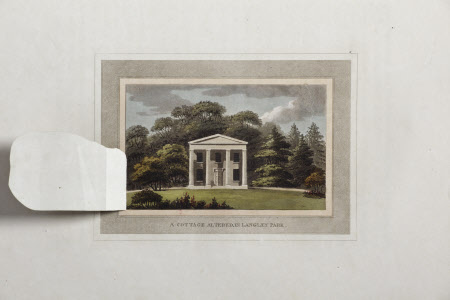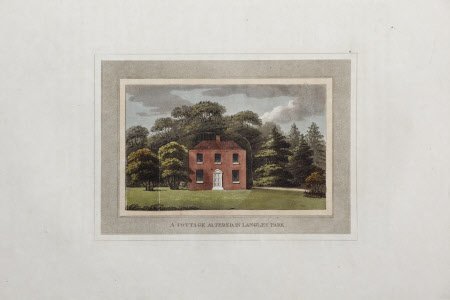Observations on the theory and practice of landscape gardening. : Including some remarks on Grecian and Gothic architecture, collected from various manuscripts, in the possession of the different noblemen and gentlemen, for whose use they were originally written: the whole tending to establish fixed principles in the respective arts. / By H. Repton.
Humphry Repton (1752 - 1818)
Category
Books
Date
1805
Materials
Place of origin
London
Order this imageCollection
Anglesey Abbey, Cambridgeshire
NT 3069942
Summary
Humphry Repton, Observations on the Theory and Practice of Landscape Gardening, London: printed by T. Bensley for J. Taylor, 1805. Binding: Twentieth-century full red straight-grained morocco over boards; double gilt fillets to form an outer border; gilt and blind rolled inner borders; gilt armorial centrepiece stamp of Lord Fairhaven [i.e. Urban Huttleston Rogers Broughton, 1st Baron Fairhaven (1896-1966), of Anglesey Abbey]; gilt-panelled spine; gilt spine title 'Landscape gardening. Repton'; sewn onto five raised bands; gilt rolled turn-ins; gilt and blind rolled board edges; gilt textblock edges; marbled endpapers; red ribbon markers.
Full description
Born in Suffolk in 1752, Repton become one of the most famous exponents of that most English of art forms, landscape gardening. As he explained in the preface to this, his longest and most important work, his task was not to apply ‘Rules of Art to the Works of Nature’ but to refine and improve them by applying two general principles, which he summarised as ‘relative fitness or UTILITY and comparative proportion or SCALE’. ‘Observations on the Theory and Practice of Landscape Gardening’ was designed, at least in part, to answer criticisms levelled at Repton by Sir Uvedale Price (1747-1829) and Richard Payne Knight (1750-1824), who both wrote in support of the picturesque. But it was also a reflection of a lifetime's work travelling around England advising clients, and typically supplying them with a beautifully illustrated ‘Red Book’ designed to highlight the potential of their estates. As Repton himself explained in print, ‘my opinions have been diffused over the Kingdom in nearly five hundred such manuscript volumes’, and many of them still survive. The Red Books were, of course, a clever marketing device, but by publishing hand-coloured aquatints of facsimiles of his famous ‘before and after’ sketches in a single volume, Repton was able to circulate very widely material which would otherwise have been accessible only to his original patrons. And though many of his designs were indeed issued in the pages of periodicals like ‘Peacock's Polite Repository’, an expensive colour-plate book – this one sold for four guineas to subscribers in the original edition of 1803 – was clearly a much more effective way of evoking the appearance of the original watercolours. In the case illustrated here, showing the ‘after’ sketch above, Repton's customer was Sir Peter Burrell, of Langley Park, near Beckenham, in Kent. The Langley Red Book, submitted in 1790, is today in the British Architectural Library in London. In a foot-note to the text, Repton himself anticipated the likely reaction of his customers in lauding the fact that ‘the Art of colouring plates in imitation of drawings has so far improved of late’; but in an important (and to modern sensibilities perhaps slightly salutary) aside, in the same breath he also thanked his colourist, ‘Mr. Clarke, under whose direction a number of children have been employed to enrich this volume’. Text adapted from Mark Purcell's entry in ‘Treasures from Lord Fairhaven’s Library at Anglesey Abbey’, National Trust, 2013, cat. 21, pp. 84-85.
Bibliographic description
16, 222, [2] p., [27] leaves of plates (1 folded) : ill., maps, plans, port. ; 4to. Provenance: Twentieth-century armorial bookplate (large variant), signed Badeley 1930: ‘Urban Huttleston Rogers Lord Fairhaven’ [i.e.: Urban Huttleston Rogers Broughton, 1st Lord Fairhaven (1896-1966)]. Gilt armorial centrepiece stamp of Lord Fairhaven on upper board. Binding: Twentieth-century full red straight-grained morocco over boards; double gilt fillets to form an outer border; gilt and blind rolled inner borders; gilt armorial centrepiece stamp of Lord Fairhaven [i.e. Urban Huttleston Rogers Broughton, 1st Baron Fairhaven (1896-1966), of Anglesey Abbey]; gilt-panelled spine; gilt spine title 'Landscape gardening. Repton'; sewn onto five raised bands; gilt rolled turn-ins; gilt and blind rolled board edges; gilt textblock edges; marbled endpapers; red ribbon markers.
Provenance
Purchased by the future Lord Fairhaven from Brown's Antiquarian Bookshop, Eton, 14 November 1927, for £20. Nineteenth-century bookplate of George Sowerby. Bequeathed by Huttleston Rogers Broughton, 1st Lord Fairhaven (1896-1966) to the National Trust with the house and the rest of the contents in 1966.
Makers and roles
Humphry Repton (1752 - 1818), author
References
Mark Purcell, William Hale and David Person, Treasures from Lord Fairhaven’s Library at Anglesey Abbey, Swindon: National Trust; London: Scala Arts & Heritage Publishers, 2013., pp. 84-5

